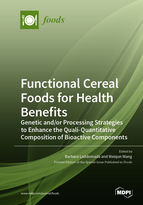Functional Cereal Foods for Health Benefits: Genetic and/or Processing Strategies to Enhance the Quali-Quantitative Composition of Bioactive Components
A special issue of Foods (ISSN 2304-8158). This special issue belongs to the section "Grain".
Deadline for manuscript submissions: closed (28 February 2022) | Viewed by 52059
Special Issue Editors
Interests: phenolic acids; bioactive compounds; quality of wheat-based products; genetic diversity; traceability of agri-food products; wheat by-products
Special Issues, Collections and Topics in MDPI journals
Interests: functional foods; transgenic plants; seconday metabolites; nutraceuticals; phytochemicals; cancer prevention; weight control; exercise
Special Issues, Collections and Topics in MDPI journals
Special Issue Information
Dear Colleagues,
Cereal foods comprise a large variety of products that make up the main part of the world population’s diet. Despite decades of research to improve cereals and cereal food quality, the scenario of market needs, processing, and climate change require the coordination of research worldwide.
Cereals and cereal foods are an important source of energy (carbohydrates, proteins, and fat), as well as a range of non-nutrient bioactive components (i.e., vitamins, minerals, dietary fiber, and phytochemicals) that provide different grades of health benefits.
The main challenges for the near future include the exploration, valorization, and improvement of genetic variation for nutrients and bioactive food components; the use and implementation of biotechnological, preprocessing, and processing strategies finalized to improve their content; the evaluation of health properties for health claims.
This Special Issue is open to all contributions that may provide novel insights to enhance the health and nutritional features of cereals and cereal foods.
Dr. Barbara Laddomada
Prof. Dr. Weiqun Wang
Guest Editors
Manuscript Submission Information
Manuscripts should be submitted online at www.mdpi.com by registering and logging in to this website. Once you are registered, click here to go to the submission form. Manuscripts can be submitted until the deadline. All submissions that pass pre-check are peer-reviewed. Accepted papers will be published continuously in the journal (as soon as accepted) and will be listed together on the special issue website. Research articles, review articles as well as short communications are invited. For planned papers, a title and short abstract (about 100 words) can be sent to the Editorial Office for announcement on this website.
Submitted manuscripts should not have been published previously, nor be under consideration for publication elsewhere (except conference proceedings papers). All manuscripts are thoroughly refereed through a single-blind peer-review process. A guide for authors and other relevant information for submission of manuscripts is available on the Instructions for Authors page. Foods is an international peer-reviewed open access semimonthly journal published by MDPI.
Please visit the Instructions for Authors page before submitting a manuscript. The Article Processing Charge (APC) for publication in this open access journal is 2900 CHF (Swiss Francs). Submitted papers should be well formatted and use good English. Authors may use MDPI's English editing service prior to publication or during author revisions.
Keywords
- cereals
- dietary fibre
- protein
- fats
- minerals
- phytochemicals
- bioavailability
- anti-oxidant activity
- anti-inflammatory properties
- anti-carcinogenic mechanisms.








